
The islands of the Philippines are regularly rated among the most beautiful in the world.
Beyond what is implied by its catchy tourism campaign slogan, “It’s More Fun in the Philippines,” this 7,107-island nation promises an experience that is rich and diverse, and enticingly different from any of its neighbors in the South China Sea region. Its stunning beaches and poster-worthy waters are hard to beat for sure, but visitors will also find a unique scenario that sets the Philippines apart: It is the only Asian nation colonized by the Spanish and as a result is overwhelmingly Roman Catholic, and it is populated by a warm and friendly people whose high rate of English fluency (it is the third-largest English-speaking country in the world) is due to the country’s special relationship as one of America’s oldest Asian partners.
The United States accounts for the country’s second-largest group of visitors (after those from nearby South Korea), undiscouraged by its distant location and intrigued by this unique blend of Western head, Latino heart, and Asian soul.
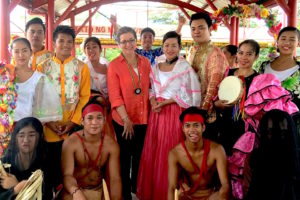
The local welcome is effusive and from the heart.
Despite first impressions of traffic congestion and inescapable neighborhoods of great poverty, Manila is a good place to spend a few days to acclimate and explore the heart and the political and economic center of the country. Located on the island of Luzon (the largest in the archipelago and also the name given to one of the three main island groups), Manila is crazy, chaotic, and vast. It is the world’s fifth-largest metropolitan area with a population of 22.9 million residents, something that translates to round-the-clock traffic jams (you can help pass the time by counting the graffiti-splashed jeepneys). Big-city lovers will find it a multilayered showcase of the Philippines’ history, along with a mix of Spanish, Chinese, and American culture and early Malay ancestry.
Ferdinand Magellan planted a cross for Spain on the nearby island of Cebu in 1521, followed by Spanish conquistador Miguel Lopez de Legazpi, who arrived in Manila in 1571. Spanish Augustinian missionaries began work on the Church of San Agustin and the adjacent monastery soon after. It evolved into a Baroque gem that is today the nation’s oldest and most important church and one of four UNESCO World Heritage churches in the Philippines.
Some 4 million people of Philippine ancestry live in the United States and make up the second-largest group of Asians in the country. Yet little is known about Filipino food’s complex identity—the result of the country’s location at the center of intercontinental trade routes for millennia and a key attraction for those visiting the capital city—and beyond.
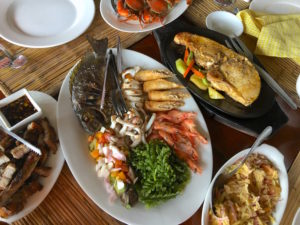
Flipino food is delicious and underrated.
Boasting more than just the much-loved lechon (an entire spit-roasted pig), adobo (braised pork or chicken), and the mind-boggling balut (boiled duck egg embryo—don’t ask), it also includes the islands’ abundance of fresh fish and seafood, along with coconut and other tropical fruits. The Filipinos love for long, abundant, and frequent meals shared with family and friends accounts for how the cuisine’s moment in the spotlight may now be arriving in the United States.
Manila may ensure that the Philippines is more than just a beach holiday, but there is no doubt that the proximity and diversity of its islands—most a brief air hop away—are the uncontested reason behind a growing number of visitors. The archipelago is blessed with spectacular natural beauty and diversity, more volcanoes per square kilometer than anywhere else in the world, and pristine waters rich with marine life that promise great snorkeling and diving.
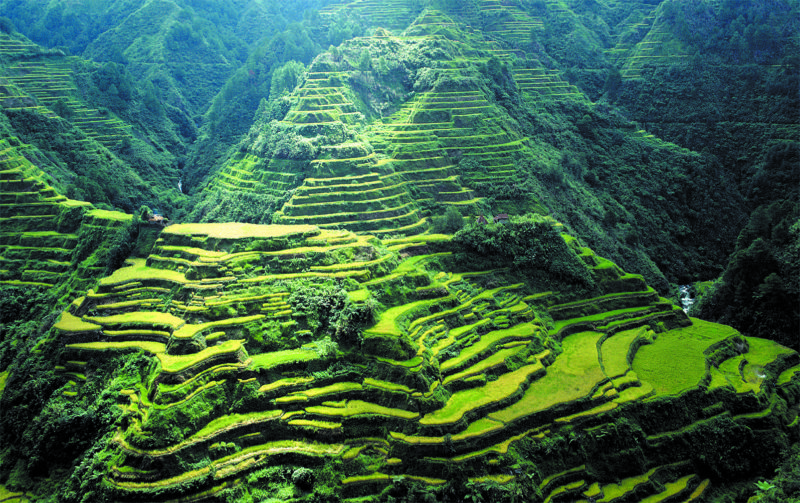
Stretching like stepping stones to the sky, the manmade Banaue Rice Terraces are some of the oldest in the world.
While luxury and upscale resorts continue to open in choice locations, areas no less beautiful but lacking high-end properties are natural draws for the more budget-sensitive Millennial market. They flock to the famous Banaue Rice Terraces of Ifugao in the Cordillera Mountains, often called the Eighth Wonder of the World. With mud- and stone-walled terraces that were built by the Ifugao people some 2000 years ago, the mountainous area is still home to much of the tribal Ifugao culture, with a man-sculpted landscape that resembles “earth art” laced by breathtaking hiking trails.
I followed the majority of island seekers and headed to the Visayas, the central island group of the Philippines—the heart of the country’s biodiversity and a longtime magnet for much of its tourism—specifically to Boracay, the most popular beach destination of the group. A serious contender as Southeast Asia’s party island, it is home to the award-winning and much-photographed White Beach.
I arrived in well-known Boracay impressed by the abundance of island beauty jammed into less than 4 square miles of land. I followed the legions drawn to its iconic coast and the aptly named White Beach, disparaged by some as over-loved and underwhelming. A walk along its powdery shore to revel in one of its transformative sunsets illustrates why it is so easily loved, and also how it is easy enough to leave the crowds and thriving nightlife behind (although I enjoyed the impromptu volleyball games and strolling families taking in the magnificent salmon-and-purple-colored sky) if you are staying at any of the newer hotels that are central yet peaceful—and can feel like light years away.
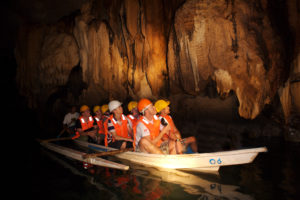
Puerto Princesa’s biggest draw is its underground river.
Palawan, a long sliver of an island that stretches for 270 miles all the way to the tip of Borneo, offers an entirely different vibe. It is sparsely populated, widely agricultural, and home to various indigenous groups, and it prides itself on being the country’s cleanest province. Puerto Princesa, its provincial capital town and site of one of two island airports, feels far smaller than its burgeoning population, and is interesting for its small museums, waterfront restaurants, and its UNESCO World Heritage Subterranean River National Park, one of the world’s longest navigable underground rivers and proudly promoted as one of the New Seven Natural Wonders of the World. Experienced divers board liveaboards that head to the world-class Tubbataha Reefs National Park, held by many as one of the world’s finest dives.
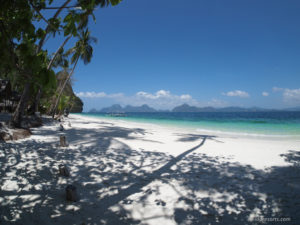
Palawan’s Bacuit Archipelago is famous for its unparalleled beauty.
Many take the 1-hour flight from Manila directly to Palawan’s northern tip, but we opted for a 5- to 6-hour car transfer from Puerto (as it is called) north on good but windy roads to enjoy some of the island’s timeless landscapes of family-owned farms framed by volcanic mountains. Our destination was the scrappy but burgeoning town of El Nido at the northern tip, and Palawan’s showpiece, which lies just offshore: the craggy and dramatic limestone outcroppings and breathtaking waters of the Bacuit Archipelago. Bangka boats slip into hidden lagoons and empty palm-lined beaches—it is reminiscent of (but less crowded than) Thailand’s Krabi coast or Vietnam’s Ha Long Bay. It is understandably one of Asia’s great locations for island hopping.
I didn’t have time to take in neighboring Coron via the new 3-and-a-half-hour FastCraft boat or daily flights from El Nido. The main island in the Calamian group, it is a minimally developed jungle-clad place known for its crystal clear lakes, and firmly on the experienced diver’s map for 24 sunken World War II–era ships, many of them largely intact.
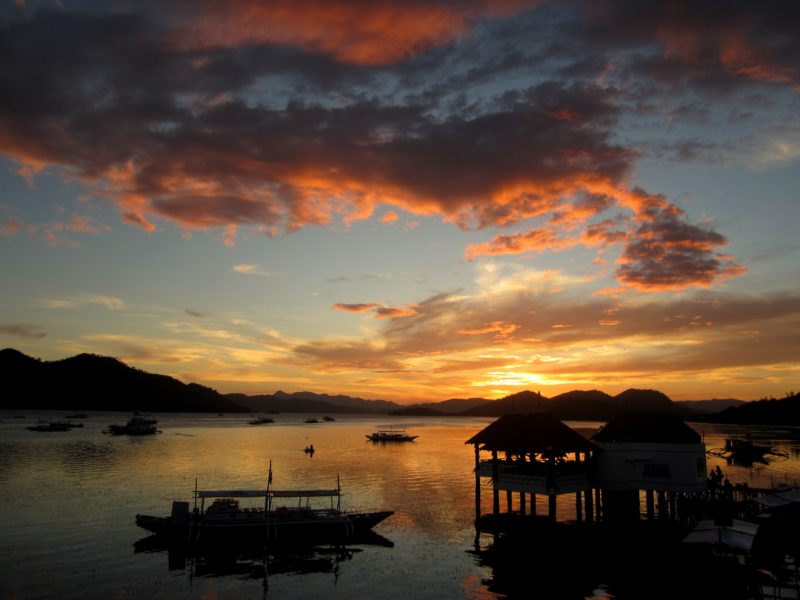
Sunsets offer a final flourish of drama to each idyllic day.
It is hard to reconcile the Philippines’ panoply of islands of immense natural beauty, populated by a smiling and friendly people as part of the same country that prompted the U.S. Department of State to issue a travel advisory in 2016 due to threats from terrorist and separatist groups. (The specific location of concern cited is in an isolated and distant corner of the Sulu Archipelago).
The memories you’ll bring home will be of empty, palm-fringed beaches and the ubiquitous and genuine welcome of the Filipino people.
 About the Book:
About the Book:
The world’s bestselling travel book is back in a more informative, more experiential, more budget-friendly full-color edition. A #1 New York Times bestseller, 1,000 Places reinvented the idea of travel book as both wish list and practical guide. As Newsweek wrote, it “tells you what’s beautiful, what’s fun, and what’s just unforgettable— everywhere on earth.” And now the best is better. There are 600 full-color photographs. Over 200 entirely new entries, including visits to 28 countries like Lebanon, Croatia, Estonia, and Nicaragua, that were not in the original edition. There is an emphasis on experiences: an entry covers not just Positano or Ravello, but the full 30-mile stretch along the Amalfi Coast.
Every entry from the original edition has been readdressed, rewritten, and made fuller, with more suggestions for places to stay, restaurants to visit, festivals to check out. And throughout, the book is more budget-conscious, with starred restaurants and historic hotels such as the Ritz, but also moderately priced gems that don’t compromise on atmosphere or charm.
The world is calling. Time to answer.
Buy the Book
Amazon | B&N | Indiebound | Workman

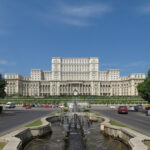
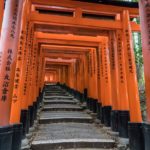
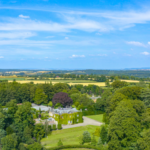
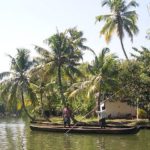
1 Comment
Shirley Hollick
April 20, 2017 at 10:53 pmGreat article. For a moment I thought it was my article because it said Gorgeous Islands and Smiling Locals which is very similar to the content of my post, http://travellittleknownplaces.com/5-jaw-droppingly-stunning-islands-of-palawan-philippines/. The Philippines are truly one of the most memorable places on earth.